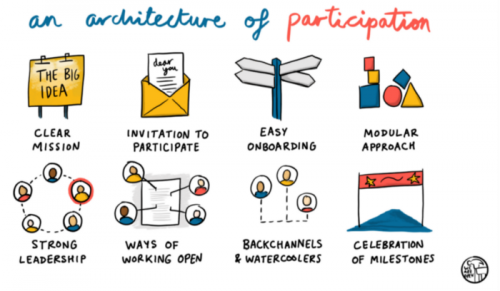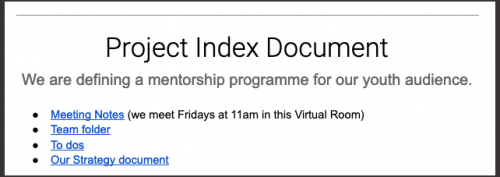cross-posted on We Are Open Co-op blog
In the Catalyst Definition Programme, we’re going to be helping charities use some of our favorite tools and methods to try and define their digital projects more succinctly. We intend to create clear plans of action, so that each charity in our cohort can take steps forward in their digital transformation projects.
We’ve written before about using Architectures of Participation (AoP) in open source projects. We find it a useful approach to scaffolding engagement, so how can we apply this useful framework to internal digital projects?
It’s actually pretty simple. We just need to contextualize the 8 points of the AoP through the lens of project management.

📝 1. Write a short, clear project mission
The mission for your charity project isn’t the same as the charity’s mission. Rather it should be small and actionable. Questions to ask yourself: Why does this project exist? What is it setting out to achieve?
“Our mission is to create a mentorship programme that engages our youth audience.”
👋 2. Set up an ongoing invitation to participate
How can your colleagues get involved in your project? Something as simple as a weekly meeting that is open to whomever would like to help, and a regular all-staff reminder email letting people know that you’ll be doing project updates and request their attention, is a call to action.
“We will have open project update meetings every Friday at 11am. Everyone is welcome to attend.”
🚀 3. Automate easy onboarding

People have a lot going on! Make it easy for folks to get involved in your project by having a canonical link (a.k.a. ‘index’) that people can use to navigate your project.
Are there small, simple tasks/activities that your colleagues can begin with? Where are they? A Google Doc index that links out to various project documentation is a perfectly acceptable way to keep your project organized.
“If you’d like to get involved, have a look at our Project Index. This document links out to our strategy, communications materials, to do list and more!”
💠 4. Break things down into a modular approach
Do colleagues have to commit to helping with everything, or is there a way which they can use their knowledge, skills, and interests to contribute to part of the project?
A digital project will have a lot of ins and outs. Alongside your Index document or webpage, having a running list of “to dos” organized in an easy to understand format breaks down a project’s complexity into more actionable tasks. There are a variety of tools designed for interactive project management. Check out tools like Trello or Asana, or just create an online spreadsheet! Explain your project management board/document.
“This online spreadsheet is a running list of our tasks. You are welcome to self-assign a task by adding your name in the “Assignee” column. We set priorities and assign tasks collectively at our Friday meetings, which you are welcome to attend!”
💪 5. Establish strong leadership
Do the people in control of the project embody the mission? Do they have the respect of their colleagues? Have they got the capacity to make the project a success?
It’s important to have someone keeping a bird’s eye view of everything to do with the project. Make sure the modular approach you’re using stays up-to-date, and empower your colleagues to get involved. In particular, strong leaders ask for help! Don’t be afraid to reach out to a colleague and tell them what you need. At the end of the day, all of your colleagues are working to advance the charity’s overarching mission. If you’re clear about your project mission, others will be willing to help where they can.
A strong leader needs to be patient and helpful towards people trying to get involved. Although you might think your overview is easy to understand, others might tick just a bit differently. Again, asking someone for exactly what you need is the best way to move your project forward.
“We call ourselves Team Project. If you have any questions, ask Laura, Bryan or Doug. While Laura has the overview, Bryan is our go-to visualization lead and Doug is working on everything that has to do with documentation. You can get in touch with us by emailing contact[at]weareopen.coop”
🪟 6. Work openly and transparently
Does the project have secret areas, or is everything out in the open? We recommend working as openly as possible, particularly inside your organization. Working openly is a continuum, however, and there are some things that cannot be public. That’s OK! Just make sure that your colleagues can easily access the project documentation.
“Everything you need to know about this project is inside the Project Index. We’ve listed our contact information and typical communication channels there as well.”
💬 7. Set up backchannels and watercoolers
Are there ‘social’ spaces for members of the project to interact over and above those focused on project aims?
All work and no play makes Jack a dull boy. Generate a community of caring with some off-topic ways for your colleagues to engage with you, each other and the project. Try starting meetings with a fun madlib and set up a chat space that isn’t strictly business. Share funny things from the internet and remember that while your project is serious, people will engage more if there’s a culture of fun too :)
“Join our Slack channels! We have one for general business, individual project channels, and several for sharing cat pictures and other memes.”
🎉 8. Celebrate milestones
Does the project recognise the efforts and input of contributors? Be sure and thank your colleagues for their input at every opportunity. It’s really important to let people know that you value their contribution. Document a celebration structure for your milestones to remind yourself and your team that you need to say thanks!
“Bryan has done 10 tasks for this project, let’s mention him in a thank you email.”
“Dear colleagues, We have completed Phase One of our Six Phase Plan to invent a mentorship programme. We have a strategy, a visual communication direction and a structured to do list. Thank you to everyone who has contributed thus far, and especially to Bryan who has gone above and beyond! Get involved in Phase Two at our Phase Two kickoff call.”
🏁 Finally… be flexible!
An Architecture of Participation is a useful way to organize your project as it provides a simple to use framework that helps you cover all your bases. An important final tip: Stop to take stock on a regular basis — if a particular piece of your Architecture isn’t working, it can affect the rest of the project. Allow yourself and your team to grow and change along with your project!